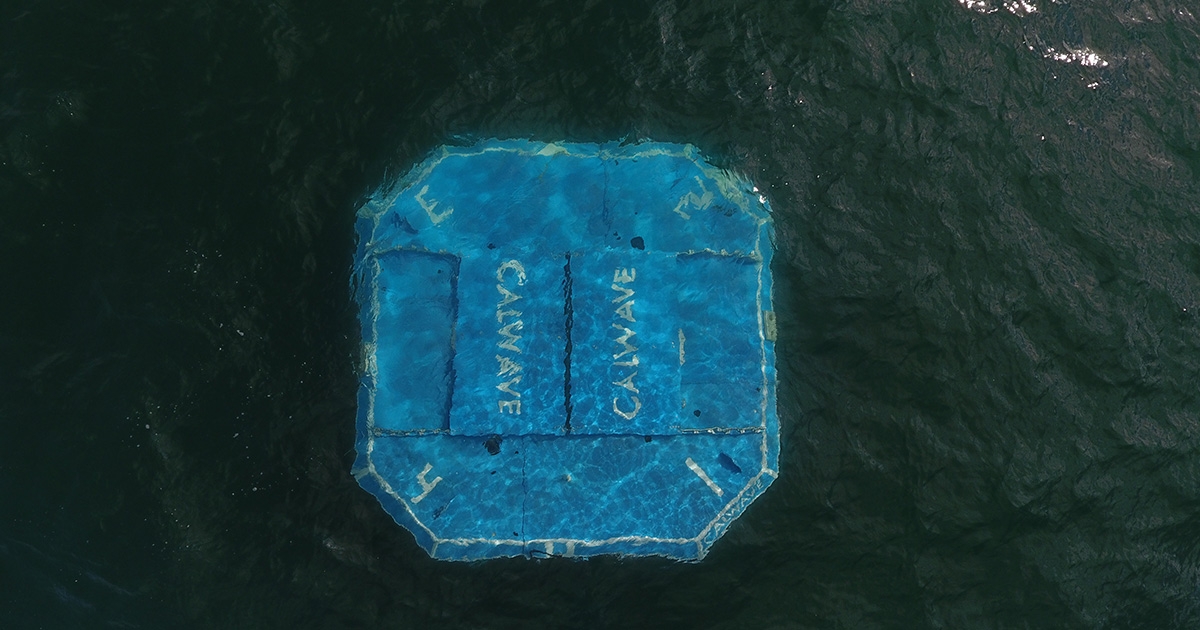Harnessing Energy Below the Water

Unlocking the power of the ocean has undoubtedly faced several fundamental challenges. It’s not too difficult to imagine: the ocean can be as unforgiving and treacherous as it is resource-abundant and life-sustaining.
From a technical perspective, the complexity of harnessing wave power as an energy source lies in the design, performance, and cost of operating devices in the open ocean—a corrosive, volatile, and sometimes violent environment.
While the evolution of the marine energy industry has led to a host of designs ranging from floating buoys to snake-like attenuators to address these pain points, CalWave has developed a novel solution that seeks to work with the ocean rather than against it.
xWAVE: SUBSEA INNOVATION
CalWave’s xWave product family is built on a promising architecture that serves as a scalable solution for tapping into the renewable energy of ocean waves. Unlike past approaches, CalWave’s xWave technology breaks through fundamental industry challenges by being lightweight, efficient, durable, and cost-effective.
Many wave energy developers have relied on building devices out of heavy steel to survive aggressive seas and storms, but xWave designs use a far lighter, less expensive technique based on the principles of submersion. Instead of bobbing on the ocean’s surface, xWave devices operate fully submerged and, therefore, are able to shelter from aggressive swells. As a result, the easily deployable technology achieves high performance through extracting energy from all degrees of freedom while being able to control structural loads in any event. As a bonus, our subsea design keeps devices hidden, eliminating any concerns of visual pollution.
CURRENT TESTING IN CALIFORNIA
In September 2021, CalWave deployed its xWave pilot unit, x1, off the Scripps Institution of Oceangraphy’s research pier in San Diego, California. For the next 6 months, the device will be tested with the goal of validating the performance and reliability of in open ocean.
In this sea trial funded by the US Department of Energy, the x1 wave energy converter (WEC) is operating at a 26-meter water depth and the submerged 15-foot buoy is anchored at the test area. But all these numbers are negotiable for the next iterations: xWave devices can be smaller or larger to suit a customer’s needs and can work in a variety of depths and distances from shore.
Further, CalWave is collaborating with PNNL & Integral Consulting, Inc. for observation of the device using three different monitoring tools: a noise spotter buoy, a drifting hydrophone, and three long-term bottom-mounted hydrophones. These instruments will allow scientists to collect data on how the machines impact the marine ecosystem through noise, collisions, or ecosystem changes.
FUTURE DEVELOPMENTS
Following the pilot demonstration, CalWave plans to deploy a larger unit at PacWave, the first commercial-scale, utility grid-connected wave energy test site in the US, rated for 20 MW.
CalWave’s technology is also well suited for the power needs of end-users of the blue economy with applications in aquaculture, security and defense, ocean science, disaster recovery, and others that require access to power and data in remote offshore locations.
CalWave’s xNode is another product offering specifically designed to enable the Ocean Internet of Things by providing access to power and data offshore. This versatile, adaptable, and resilient ocean observing platform features a standard baseline ocean science sensor suite that maximizes data collection and cross-functional interest for any offshore mission, as well as a standard payload interface enabling capability for multiple sensors and payloads to be added. In addition to providing remote power and data offshore, the xNode stands out through innovative features such as a digital twin, autonomous shelter/survival functions, on-board edge computing, and a compact size enabled by an inflatable hull. Similar to xWave designs, it is lightweight, low cost, resilient for storm survivability, and easily stores, ships, and deploys.
THE OPPORTUNITIES
The wave energy industry is at an inflection point and CalWave is taking a leading role in unlocking the vast and steady carbon-free power from ocean waves worldwide. The Department of Energy recently published a study including an updated resource assessment and found that wave power can provide up to 30% of the 2019 energy consumption in the US, representing the technically feasible resource potential and not just the theoretical. Additionally, it has one of the lowest lifecycle emissions at 17 gCO2e/kWh, and forecasts project that ocean energy has the ability to displace up to 1.38 - 1.9 GtCO2e emissions annually.
As several governments aim to transition to 100% clean energy, such as California through the passage of Senate Bill 100 in 2018, CalWave’s scalable technology has the potential to complement existing renewable energy forms to provide reliable power when no other renewables are available. Like wind turbines, wave energy converters (WECs) are scalable in power rating and CalWave plans to offer product lines with different power ratings in the coming years. Utility-scale units can be co-located with offshore wind farms using the same electrical export infrastructure and achieve a 90% joint capacity factor due to the complementary production profile of wind and wave power.
CalWave sees an opportunity to work closely with small island developing states (SIDS). SIDS are the ideal benefactors of our technology, as they are located near sub-sea wind resources, face high diesel fuel imports, and are often affected by hurricanes. Tourism is one of their biggest industries, so having a renewable resource that works completely underwater and doesn’t take up space while providing power close to baseload is a great opportunity for these communities.
As an active member of the National Hydropower Association’s Marine Energy Council, we call for domestic marine energy to reach at least 50 MW by 2025, 500 by 2030, and 1 GW—approximately what 3 million solar panels can produce—by 2035.
This story was originally featured in ON&T Magazine's November/December 2021 issue. Click here to read more.

